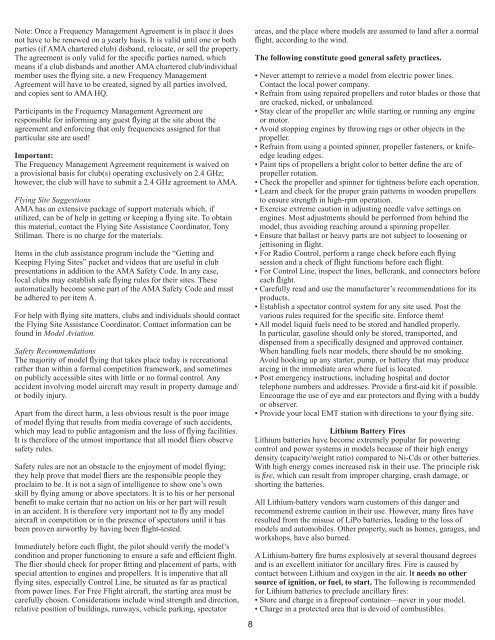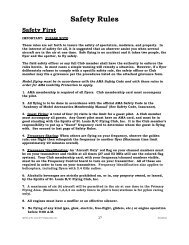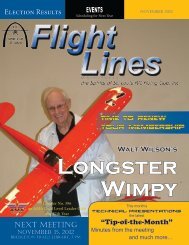Membership Manual - Spirits of St. Louis R/C Flying Club
Membership Manual - Spirits of St. Louis R/C Flying Club
Membership Manual - Spirits of St. Louis R/C Flying Club
You also want an ePaper? Increase the reach of your titles
YUMPU automatically turns print PDFs into web optimized ePapers that Google loves.
Note: Once a Frequency Management Agreement is in place it does<br />
not have to be renewed on a yearly basis. It is valid until one or both<br />
parties (if AMA chartered club) disband, relocate, or sell the property.<br />
The agreement is only valid for the specific parties named, which<br />
means if a club disbands and another AMA chartered club/individual<br />
member uses the flying site, a new Frequency Management<br />
Agreement will have to be created, signed by all parties involved,<br />
and copies sent to AMA HQ.<br />
Participants in the Frequency Management Agreement are<br />
responsible for informing any guest flying at the site about the<br />
agreement and enforcing that only frequencies assigned for that<br />
particular site are used!<br />
Important:<br />
The Frequency Management Agreement requirement is waived on<br />
a provisional basis for club(s) operating exclusively on 2.4 GHz;<br />
however, the club will have to submit a 2.4 GHz agreement to AMA.<br />
<strong>Flying</strong> Site Suggestions<br />
AMA has an extensive package <strong>of</strong> support materials which, if<br />
utilized, can be <strong>of</strong> help in getting or keeping a flying site. To obtain<br />
this material, contact the <strong>Flying</strong> Site Assistance Coordinator, Tony<br />
<strong>St</strong>illman. There is no charge for the materials.<br />
Items in the club assistance program include the “Getting and<br />
Keeping <strong>Flying</strong> Sites” packet and videos that are useful in club<br />
presentations in addition to the AMA Safety Code. In any case,<br />
local clubs may establish safe flying rules for their sites. These<br />
automatically become some part <strong>of</strong> the AMA Safety Code and must<br />
be adhered to per item A.<br />
For help with flying site matters, clubs and individuals should contact<br />
the <strong>Flying</strong> Site Assistance Coordinator. Contact information can be<br />
found in Model Aviation.<br />
Safety Recommendations<br />
The majority <strong>of</strong> model flying that takes place today is recreational<br />
rather than within a formal competition framework, and sometimes<br />
on publicly accessible sites with little or no formal control. Any<br />
accident involving model aircraft may result in property damage and/<br />
or bodily injury.<br />
Apart from the direct harm, a less obvious result is the poor image<br />
<strong>of</strong> model flying that results from media coverage <strong>of</strong> such accidents,<br />
which may lead to public antagonism and the loss <strong>of</strong> flying facilities.<br />
It is therefore <strong>of</strong> the utmost importance that all model fliers observe<br />
safety rules.<br />
Safety rules are not an obstacle to the enjoyment <strong>of</strong> model flying;<br />
they help prove that model fliers are the responsible people they<br />
proclaim to be. It is not a sign <strong>of</strong> intelligence to show one’s own<br />
skill by flying among or above spectators. It is to his or her personal<br />
benefit to make certain that no action on his or her part will result<br />
in an accident. It is therefore very important not to fly any model<br />
aircraft in competition or in the presence <strong>of</strong> spectators until it has<br />
been proven airworthy by having been flight-tested.<br />
Immediately before each flight, the pilot should verify the model’s<br />
condition and proper functioning to ensure a safe and efficient flight.<br />
The flier should check for proper fitting and placement <strong>of</strong> parts, with<br />
special attention to engines and propellers. It is imperative that all<br />
flying sites, especially Control Line, be situated as far as practical<br />
from power lines. For Free Flight aircraft, the starting area must be<br />
carefully chosen. Considerations include wind strength and direction,<br />
relative position <strong>of</strong> buildings, runways, vehicle parking, spectator<br />
8<br />
areas, and the place where models are assumed to land after a normal<br />
flight, according to the wind.<br />
The following constitute good general safety practices.<br />
• Never attempt to retrieve a model from electric power lines.<br />
Contact the local power company.<br />
• Refrain from using repaired propellers and rotor blades or those that<br />
are cracked, nicked, or unbalanced.<br />
• <strong>St</strong>ay clear <strong>of</strong> the propeller arc while starting or running any engine<br />
or motor.<br />
• Avoid stopping engines by throwing rags or other objects in the<br />
propeller.<br />
• Refrain from using a pointed spinner, propeller fasteners, or knifeedge<br />
leading edges.<br />
• Paint tips <strong>of</strong> propellers a bright color to better define the arc <strong>of</strong><br />
propeller rotation.<br />
• Check the propeller and spinner for tightness before each operation.<br />
• Learn and check for the proper grain patterns in wooden propellers<br />
to ensure strength in high-rpm operation.<br />
• Exercise extreme caution in adjusting needle valve settings on<br />
engines. Most adjustments should be performed from behind the<br />
model, thus avoiding reaching around a spinning propeller.<br />
• Ensure that ballast or heavy parts are not subject to loosening or<br />
jettisoning in flight.<br />
• For Radio Control, perform a range check before each flying<br />
session and a check <strong>of</strong> flight functions before each flight.<br />
• For Control Line, inspect the lines, bellcrank, and connectors before<br />
each flight.<br />
• Carefully read and use the manufacturer’s recommendations for its<br />
products.<br />
• Establish a spectator control system for any site used. Post the<br />
various rules required for the specific site. Enforce them!<br />
• All model liquid fuels need to be stored and handled properly.<br />
In particular, gasoline should only be stored, transported, and<br />
dispensed from a specifically designed and approved container.<br />
When handling fuels near models, there should be no smoking.<br />
Avoid hooking up any starter, pump, or battery that may produce<br />
arcing in the immediate area where fuel is located.<br />
• Post emergency instructions, including hospital and doctor<br />
telephone numbers and addresses. Provide a first-aid kit if possible.<br />
Encourage the use <strong>of</strong> eye and ear protectors and flying with a buddy<br />
or observer.<br />
• Provide your local EMT station with directions to your flying site.<br />
Lithium Battery Fires<br />
Lithium batteries have become extremely popular for powering<br />
control and power systems in models because <strong>of</strong> their high energy<br />
density (capacity/weight ratio) compared to Ni-Cds or other batteries.<br />
With high energy comes increased risk in their use. The principle risk<br />
is fi re, which can result from improper charging, crash damage, or<br />
shorting the batteries.<br />
All Lithium-battery vendors warn customers <strong>of</strong> this danger and<br />
recommend extreme caution in their use. However, many fires have<br />
resulted from the misuse <strong>of</strong> LiPo batteries, leading to the loss <strong>of</strong><br />
models and automobiles. Other property, such as homes, garages, and<br />
workshops, have also burned.<br />
A Lithium-battery fire burns explosively at several thousand degrees<br />
and is an excellent initiator for ancillary fires. Fire is caused by<br />
contact between Lithium and oxygen in the air. It needs no other<br />
source <strong>of</strong> ignition, or fuel, to start. The following is recommended<br />
for Lithium batteries to preclude ancillary fires:<br />
• <strong>St</strong>ore and charge in a firepro<strong>of</strong> container—never in your model.<br />
• Charge in a protected area that is devoid <strong>of</strong> combustibles.








